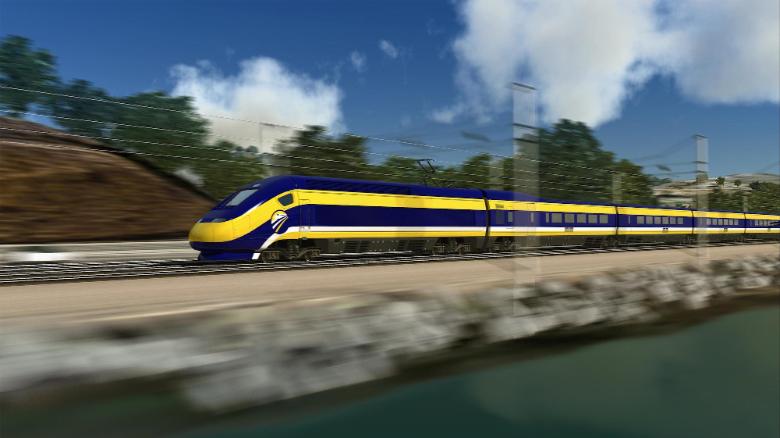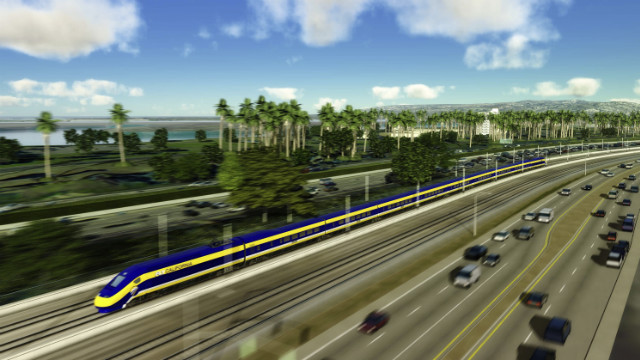(CNN)In President Donald Trump's world, Democrats are after your cars and want to force everyone onto trains.
"I really don't like their policy of taking away your car, of taking away your airplane rights, of 'let's hop a train to California,'" he said during a speech in El Paso, Texas, this past week, drawing a predictable chorus of boos.
He was talking about the Democrats' Green New Deal proposal, but it was a complete mischaracterization of what's actually in the plan, recently introduced by freshman New York Rep. Alexandria Ocasio-Cortez and Massachusetts Sen. Ed Markey. It suggests new US investment in high speed rail, as a cleaner alternative to automobile and air traffic.
But that wasn't the only time the President dunked on rail this week.
Trump wasted no time making fun of California Democratic Gov. Gavin Newsom, who announced in his State of the State address Tuesday that he was going to scale back a massive planned high speed rail project. The train might ultimately carry passengers from megalopolis of Los Angeles to the metro area that includes both Silicon Valley and San Francisco, but for now, Newsom said, they're just going to focus on the line from Bakersfield (population: 380,000) to Merced (population: 83,000).
"The whole project is a 'green' disaster," Trump said on Twitter, and demanded that California return $3.5 billion in funding for the project that was first doled out as part of the 2009 federal stimulus meant to kickstart the country out of the Great Recession.
The President loves to hate on California. He's trashed the state's wilderness management practices, suggesting its forests should be raked to prevent wildfires, he's criticized the state and its cities for protecting undocumented immigrants. His policies are at odds with California's opposition to offshore drilling, its emissions standards for cars, its legalized marijuana and more.
Newsom -- who, incidentally, used to be married to Kimberly Guilfoyle, who now dates Trump's eldest son -- quickly fired back, making clear the high speed rail money would not be returned and the rail system is still part of the California plan. But it's equally clear that the state started building something when it wasn't clear there was enough federal or private money to finish the job.
While the Central Valley leg was always supposed to be the first phase of the project, the fact remains that 11 years after voters first said they'd pay billions to build it, the new governor was transmitting a dose of realism to Californians. The over-schedule and over-budget voter-approved dream of a 200 plus mile-an-hour trip linking the most populous state's two most populous areas won't happen any time soon.
But why not? It feels like every other developed part of the world has invested in such trains -- they're all over Europe and Asia. Yet there isn't any true high speed rail in all of North America. Not even Canada has one.
The Northeast corridor, from Washington, DC, to Boston, has Amtrak's Acela, but it does not travel as fast as the bullet trains in other countries. Acela tops out at 150mph and then only for a smidge of its route. Trains in China, Japan and Europe zip along at more than 200mp.
Trump, in fact, used to complain about the lack of fast trains in the US on the campaign trail in 2016 he would use the lack of high speed rail to tell audiences the US was losing to China.
"We have the worst transportation system and train system," he said in Harrisburg, Pennsylvania, in April of 2016. "In China, they have trains that go 250 miles an hour. Over here, if the train goes more than 60, it's like collision territory. And we see it all the time - we've got to start rebuilding this country."
The backlog of infrastructure upgrades on roads and rails and bridges exceeds $800 billion, according to the Department of Transportation.
Trump's plan to spur $1 trillion in private infrastructure spending with a more than $200 billion federal infusion has not yet come to pass, in part because he can't find a way to pay for it. And it did not focus on rail. The Obama administration, early on, had a federal high speed rail plan, but it couldn't get money from Congress. In fact, the last high speed rail funding okayed at the federal level was ten years ago in that stimululs bill. And the only truly high speed rail project under construction is the one from Bakersfield to Merced.
Amtrak does have plans for faster trains, but they are hemmed in by their aging track system.
There is a private rail line in Florida -- Brightline -- that travels faster than most other US trains, but nowhere near 200 MPH. But it's up and running and moving passengers. Brightline has also taken over a project that would connect Los Angeles and Las Vegas.
Ambitious plans for a completely privately funded bullet train between Houston and Dallas are progressing, but have run into problems just this week as they seek to acquire land in rural Texas. Texas Central, the company behind the effort, says it is continuing with its plans.
There is local movement toward trains. It's just very, very slow, particularly in the absence of any sort of federal leadership on the issue.
Trump's infrastructure plan focused more on "transformative" new ideas. It didn't specify what, but one suggestion is further afield ideas like Elon Musk's Boring Company project, which would dig tunnels to whip cars quickly in Los Angeles, Chicago and the DC area. That, however, seems even further from reality.
It was an epic train system, the Transcontinental Railroad, a marvel of engineering and determination, that tied the United States together and let Americans spread west with greater ease and efficiency.
But it was an epic highway system, President Dwight Eisenhower's Interstate Highway System, a marvel of engineering and determination, that opened the country up 100 years later and created a sort of suburban diaspora.
And the US economy is built more around highways than around train lines today. Suburbs sprawled around freeways and so people outside of major urban areas need cars.
The highway system is funded by the gas tax, which brings in more money as people drive more cars. But while it's been a self-sustaining system, the gas tax won't cover the cost of roads for long. Trump proposed a gas tax hike in 2018, but it went nowhere.
The money invested in the Interstate Highway System coupled with the ease and independence of automobiles largely moved Americans away from rail traffic in the 1900s. Today, a lot of Americans might see high speed rail as way to give them independence from their cars. But short of bold investment, that's probably where they'll stay.




